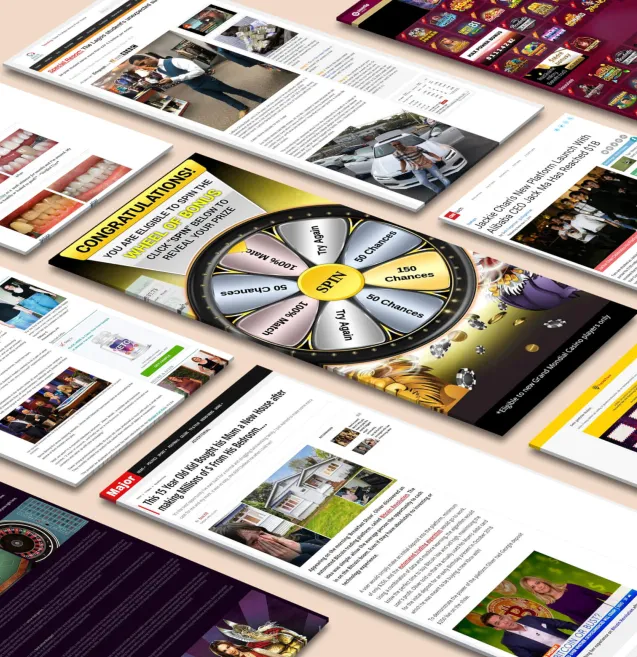
Our spy tools monitor millions of native ads from over 60+ countries and thousands of publishers.
Get StartedDigital advertising generates approximately 2% of the internet's total emissions, with native ads contributing significantly to this carbon footprint through the energy-intensive processes required for ad delivery and computation. As programmatic advertising systems execute multiple auctions and platform calls, the computational load creates substantial environmental impact that can no longer be ignored.
The challenge facing advertisers today centers on reducing carbon footprint while preserving campaign effectiveness. You need strategies that deliver strong performance outcomes without compromising your environmental responsibility. This balance becomes particularly critical as consumers and stakeholders increasingly demand sustainable business practices across all digital operations.
Low-carbon native advertising represents a practical solution to this dilemma. By implementing targeted sustainability measures, you can achieve meaningful emissions reductions without sacrificing the engagement rates and conversion metrics that drive your business success. The key lies in understanding which specific adjustments create the greatest environmental impact while maintaining advertising effectiveness.
To achieve these goals, it's essential to adopt a native advertising approach that prioritizes sustainability. This requires a strategic approach that addresses multiple aspects of campaign execution - from creative formats and delivery methods to timing and supply chain optimization. Each decision point in your advertising workflow presents opportunities to reduce environmental impact through smarter, more efficient practices.
Moreover, leveraging the advertising industry's potential to drive demand for low-carbon lifestyles can further enhance your sustainability efforts. This article presents five actionable strategies for carbon footprint reduction in native advertising, enabling you to build more sustainable campaigns that deliver results while supporting environmental goals.
The format you choose for your native ads directly affects their carbon footprint. Video-heavy formats use significantly more energy than text-based formats, requiring extensive computational resources for encoding, streaming, and rendering across devices.
Different ad formats generate varying levels of emissions based on their technical requirements:
Low-carbon creative formats deliver compelling results without the environmental cost. Text-based native ads blend seamlessly into editorial content while consuming minimal server resources. These formats load faster, reduce bandwidth usage, and require less processing power from both servers and user devices.
You can maintain engagement rates comparable to richer formats by focusing on compelling copy and strategic placement. Native text ads often outperform heavy media formats in terms of click-through rates because they feel less intrusive to users browsing content.
Standard display units represent the sweet spot between visual impact and energy efficiency. These formats provide enough creative flexibility for brand messaging while keeping file sizes manageable. When you prioritize efficient media formats, you reduce the computational load on ad servers, decrease data transfer requirements, and minimize the energy consumption of end-user devices.
Smart creative optimization means choosing formats that align with your campaign objectives while respecting environmental constraints. Simple design elements, optimized image compression, and streamlined code contribute to lower emissions without compromising your advertising goals.
Optimizing rendering processes is a critical way to reduce computational overhead in native advertising. You can significantly decrease energy consumption by implementing server-side rendering techniques that pre-process ad elements before delivery to user devices. This approach eliminates redundant client-side computations and reduces the processing burden on individual browsers.
Ad delivery efficiency improves dramatically when you limit the number of simultaneous ad loads on webpages. Industry data shows that pages with more than three concurrent native ads experience exponential increases in energy consumption due to competing rendering processes. You should establish strict ad density guidelines:
Reducing computational overhead becomes achievable through strategic refresh rate optimization. Traditional programmatic setups refresh ads every 30 seconds, creating unnecessary server requests and energy spikes. You can extend refresh intervals to 60-90 seconds without measurable impact on engagement rates.
The rendering pipeline itself offers multiple optimization opportunities. Implementing progressive enhancement techniques allows basic ad content to load first, followed by enhanced features only when bandwidth permits. This method ensures core messaging reaches users while minimizing energy waste from failed rich media loads.
Browser caching strategies play an essential role in delivery optimization. You can configure native ad assets to cache locally for 24-48 hours, reducing repeated server calls for identical creative elements. This approach cuts energy consumption by up to 40% for returning visitors while maintaining fresh campaign messaging through dynamic text updates.
Creating a lightweight scoring rubric changes the way you assess and choose native ad creatives based on their environmental impact. This method assigns numerical values to various creative elements, prioritizing assets that reduce energy consumption while maintaining campaign effectiveness.
Your scoring system should evaluate creative payloads across multiple dimensions:
Smaller payload sizes directly lead to less server processing needs and quicker content delivery. When your native ads load quickly, data centers use less electricity per impression, resulting in a measurable decrease in carbon emissions. You'll see an improved user experience along with environmental benefits, as lightweight creatives usually have better engagement rates due to faster rendering times.
However, it's important to understand that the success of these ads doesn't solely rely on their lightweight nature. As mentioned in the article about measuring what matters, metrics like active time and scroll depth are crucial in evaluating ad performance.
Sustainable ad design doesn't mean sacrificing visual appeal or performance metrics. You can keep captivating creative elements by optimizing image quality settings, choosing efficient color palettes, and removing unnecessary animations. Text-based native ads consistently score highest in Low-Carbon Native: Cutting Ad Emissions Without Cutting Performance frameworks, delivering strong click-through rates while minimizing computational overhead.
Creative payload optimization becomes a competitive advantage when you apply consistent scoring standards across all campaigns. Advertisers who adopt these metrics often find out that streamlined creatives not only lessen environmental impact but also enhance loading speeds on slower network connections, broadening their potential audience reach without raising carbon costs.
Programmatic buying optimization transforms your advertising strategy by streamlining the complex web of intermediaries that inflate both costs and carbon emissions. Each auction involves multiple supply-side platforms, demand-side platforms, and data management platforms creating unnecessary computational overhead. You can dramatically reduce this waste by mapping your current supply paths and identifying redundant connections.
Cutting redundant supply paths requires a systematic approach to your programmatic infrastructure. Start by auditing your current buying routes and eliminate duplicate pathways that serve the same inventory. Direct deals with publishers often provide cleaner, more efficient access than going through multiple intermediaries. You'll discover that shorter supply chains not only reduce carbon footprint but also improve bid response times and reduce fees.
Modern carbon estimation tools now integrate directly with demand-side platforms, providing real-time emissions data for your campaigns. These platforms calculate energy consumption based on factors like server locations, data transfer volumes, and computational complexity. You can use this data to set carbon budgets alongside your financial budgets, making sustainability a core buying criterion rather than an afterthought.
Low-carbon inventory targeting becomes possible when you partner with media owners who prioritize renewable energy sources for their data centers. Publishers like those participating in sustainability initiatives often provide inventory tags that identify their green hosting status. You can configure your buying algorithms to favor these environmentally conscious partners, creating a competitive advantage for publishers who invest in clean energy infrastructure.
Your programmatic strategy should include carbon efficiency as a key performance indicator, weighing emissions data alongside traditional metrics like viewability and click-through rates.
Campaign timing is crucial in reducing the carbon footprint of your native advertising efforts. The electricity that powers data centers varies significantly throughout the day, which directly affects the carbon intensity of your ad campaigns. During busy hours when businesses are operating at full swing, power grids heavily depend on fossil fuel sources to meet the high demand for electricity. On the other hand, off-peak advertising periods often coincide with times when there is an abundance of renewable energy available.
To better understand how you can optimize your campaign timing, it's important to know how renewable energy data centers operate. These facilities are designed to run most efficiently when wind and solar generation is at its peak. Typically, solar power generation reaches its highest point during midday hours while wind power generation peaks late in the evening.
By leveraging these patterns, you can strategically schedule your native ad campaigns during these optimal windows. For instance, late evening hours (from 10 PM to 6 AM) and early afternoon periods (from 12 PM to 3 PM) are often when most regions experience the cleanest energy mix.
The difference in carbon intensity between peak and off-peak hours can be significant:
Implementing strategic campaign timing doesn't mean you have to compromise on reach or performance. In fact, native ads that are scheduled during off-peak periods often benefit from lower competition and reduced costs per impression.
The key here is to analyze how your target audience engages with content and identify any overlaps with the windows when renewable energy is available. By doing so, you can ensure that your ads are not only reaching their intended audience but also being powered by cleaner sources of energy.
To make informed decisions about when to run your ad campaigns, it's essential to have access to regional electricity grid data. This information can provide valuable insights into the carbon intensity levels in specific areas and help you determine the best times to launch your ads.
One tool that can assist you in this process is the WattTime API. This platform offers real-time forecasts of carbon intensity, allowing you to automatically adjust your campaign schedules based on the cleanest energy sources available in your target markets.
By combining knowledge about renewable energy generation patterns with data from regional electricity grids, you can optimize both the environmental impact and effectiveness of your native advertising efforts.
Carbon footprint measurement tools have become essential for advertisers seeking to quantify their environmental impact. Platforms like Scope3, Good-Loop, and Sharethrough's GreenPMPs provide detailed emission tracking native ads capabilities, calculating CO2 emissions based on data transfer, server processing, and device energy consumption. These tools analyze everything from creative file sizes to programmatic auction complexity, giving you precise metrics on your campaign's environmental footprint.
Sustainability reporting transforms raw emission data into actionable intelligence. You can track metrics such as:
Transparent reporting builds trust with environmentally conscious consumers and stakeholders. Agencies like Havas and GroupM now include carbon impact assessments in their standard campaign reports, demonstrating accountability and commitment to native ad sustainability.
Data-driven optimization requires consistent measurement across all campaigns. You should establish baseline emissions for your current native ad operations, then test different strategies while monitoring their environmental impact. This iterative approach allows you to identify which creative formats, delivery methods, and timing strategies deliver the best performance-to-emissions ratio.
Low-Carbon Native: Cutting Ad Emissions Without Cutting Performance becomes achievable when you have reliable measurement systems guiding your decisions. Regular carbon audits help you spot inefficiencies and opportunities for improvement across your entire advertising ecosystem.
The world of digital advertising is at a crucial point where sustainable native advertising is not only important for the environment but also gives businesses a competitive edge. You now have five practical ways to lower your carbon footprint while still running effective campaigns—showing that it's possible to balance performance and sustainability.
The future of low-carbon ads looks bright as more platforms introduce tools for tracking carbon emissions and advertisers demand transparency in their environmental impact. Industry leaders are already proving that Low-Carbon Native: Cutting Ad Emissions Without Cutting Performance isn't just a catchy phrase—it's a proven method.
By committing to these strategies, you're positioning yourself ahead of others. As renewable energy sources grow and programmatic platforms become more efficient, the carbon impact of digital advertising will naturally decrease. However, the brands and agencies that take action today will enjoy benefits such as:
Start with one strategy, measure your impact, and gradually expand your sustainable native advertising practices from there.
Receive top converting landing pages in your inbox every week from us.
Quick Read
This blog analyzes post-Black Friday ad data to uncover key insights into evolving 2025 consumer behavior. It highlights shifting buying patterns, preferred ad formats, and the factors driving purchase decisions this season. Readers will gain valuable takeaways to refine their future campaigns based on real performance trends. Ideal for marketers seeking data-driven strategies to stay ahead in the competitive digital landscape.
Liam O’Connor
7 minNov 23, 2025
Quick Read
Generative AI is changing the way marketers create content, gain insights, and find solutions. It uses complex algorithms to analyze large amounts of data and generate outputs that mimic human thinking. This technology is a game-changer for marketers who want to automate and personalize their strategies on a larger scale than ever before.
Priya Kapoor
7 minNov 14, 2025
How-To
Native advertising has transformed the digital marketing landscape by seamlessly blending promotional content with the organic user experience. Unlike traditional banner ads that interrupt your browsing, native ads integrate naturally into the platform's content flow, making them feel less like advertisements and more like valuable information.
Elena Morales
7 minNov 8, 2025




